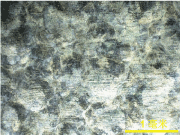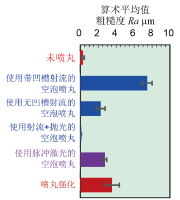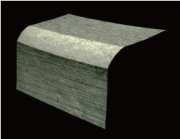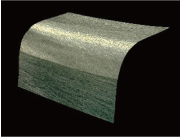简介
镁合金由于比强度高,因此有望应用于许多领域,其疲劳强度也需要根据应用目的进行提高。
据报道,使用浸没式高速水射流的空泡破裂冲击喷丸使镁合金AM60B在107的疲劳强度提高了约17%[1]。以AZ31镁合金为例,报道了硬度的提高和残余压应力的引入,[2-5]并确认了耐腐蚀性能的提高[2,5]。然而,据报道,由于表面粗糙度的增加,很难像钢一样通过喷丸强化来识别疲劳强度的显着提高[4]。在使用激光烧蚀的激光喷丸中,虽然引入了孪晶,但由于加工硬化不够,难以提高疲劳强度[6]。
结果表明,在相对喷丸强度条件下,喷丸强化、空泡喷丸和激光喷丸等强化方法对不锈钢的堆垛层错密度和孪晶密度的影响不同[7]。而且,据报道,不锈钢在疲劳过程中引入的残余压应力的松弛受所用喷丸方法的影响[8]。因此,由于表面粗糙度和位错和孪晶密度的增加取决于喷丸方法,所以可能有一种合适的喷丸方法来提高AZ31的疲劳强度。
在传统的激光喷丸中,通过激光烧蚀将局部塑性变形引入工件,并使用水等介质限制冲击波的惯性力[9]。众所周知,以浸没式激光喷丸为例,激光烧蚀后会产生气泡,它在气泡破裂时产生与空化气泡相同的冲击。在本文中,气泡被命名为“激光空化”。测量水中压力波的幅度时,激光烧蚀处的压力大于气泡破裂处的压力[10-12]。然而,以穿过材料的冲击为例,气泡破裂的影响大于激光烧蚀[11,12]。据报道,材料内部的表面凹痕和塑性区域的比率表明空泡喷丸具有介于喷丸和激光喷丸之间的特性[13]。这可能取决于喷丸时的应变率[14]。即,喷丸过程中塑性变形坑的产生机理非常重要。在传统的空泡喷丸中,“流体动力空化”是由带有空化的浸没高速水射流(空化射流)产生的[15]。在本实验中,“流体动力空化”和“激光空化”用于空泡喷丸。
在本文中,为了研究AZ31空泡喷丸的疲劳性能,使用浸没射流和脉冲激光的空泡喷丸对AZ31B制成的试样进行处理,然后通过与喷丸强化相比的平面弯曲疲劳试验进行评估。
材料和方法
被测材料为镁合金AZ31B。试样的厚度为4毫米。试样边缘通过端铣成为半径为1mm的圆。疲劳性能通过位移控制的平面弯曲疲劳试验机进行评估。
试样由使用空化射流(见图1)和脉冲激光(见图2)的空泡喷丸进行处理。在空化射流时,注射压力为30MPa,喷嘴喉道直径d为2毫米。以使用射流的空泡喷丸为例,分别在有或没有凹槽的情况下对试样以18.75毫米/分钟速度进行处理。还研究了“使用射流+抛光的空泡喷丸”,即使用以18.75毫米/分钟的速度运行的射流的空泡喷丸,该射流带有凹槽以及在空泡喷丸后用于降低表面粗糙度的抛光。
对于使用脉冲激光的空泡喷丸系统,使用带Q开关的Nd:YAG激光,其波长为1,064nm,最大脉冲能量为0.35J。
考虑到疲劳寿命随脉冲密度变化,试样以16脉冲/毫米2处理。
为了比较空泡喷丸和喷丸强化之间的疲劳性能,还对试样进行了循环型喷丸强化处理,喷丸强化由水射流通过三个直径为0.8毫米的孔以15MPa的注射压力进行加速,如图3所示。射击的直径和次数分别为3.2毫米和500次。腔室的内径为54毫米,间隔距离为50毫米。以30毫米/分钟的速度对试样进行处理。
通过空泡喷丸和喷丸强化提高疲劳强度
图4说明了弯曲疲劳试验的结果。图5显示了通过数字显微镜观察到的试样表面。弯曲应力的幅值通过Little法获得的107未喷丸的疲劳强度归一化,[16]即96.8MPa。请注意,喷丸强化处理的疲劳性能受凹槽几何形状的影响,因为凹槽因喷丸的塑性变形而变形。如图4所示,使用脉冲激光的空泡喷丸的疲劳强度最好,空泡喷丸+抛光次之,使用无凹槽射流的空泡喷丸第三,喷丸强化第四。以使用带凹槽射流的空泡喷丸为例,弯曲应力相对较高振幅下的疲劳寿命优于喷丸强化和无凹槽空泡喷丸的疲劳寿命。然而,在相对较低的弯曲应力幅值下的疲劳寿命比未喷丸的疲劳寿命短。
为了研究疲劳性能的原因,图6显示了试样的表面粗糙度,图7显示了试样边缘的情况。如图5、图6和图7所示,有凹槽的空泡喷丸表面比无凹槽的空泡喷丸表面粗糙。以空泡喷丸为例下,气泡破裂处的冲击力随着气泡破裂区域的压力而增加。当使用凹槽时,试样表面的冲击压力增大,然后气泡破裂的冲击力增大。因此,有凹槽的表面比没有凹槽的表面更粗糙。
如图7所示,喷丸强化的边缘因射击的碰撞而变形。另一方面,使用射流和脉冲激光的空泡喷丸的边缘几乎不会因冲击而变形。对比有凹槽和无凹槽的空泡喷丸,无凹槽的空泡喷丸边缘更光滑。
结语
为了证明空泡喷丸对镁合金AZ31B疲劳性能的改善,对AZ31B进行了浸没水射流和浸没脉冲激光处理,并进行了平面弯曲疲劳试验。结果表明,与未喷丸的空泡喷丸相比,使用脉冲激光的空泡喷丸处使107时的疲劳强度提高了1.55倍。
致谢
这项工作得到了JSPS KAKENHI(授权号18KK0103和20H02021)的部分支持。
参考文献
[1] H. Soyama, and N. Miyamoto, “Improvement of Fatigue Strength of Light Metallic Materials by Cavitation Peening,” Proc.1st Inter.Workshop on Cavitation Peening and Related Phenomena, pp. 29-30, 2015.
[2] S. Bagherifard et al., “Effects of nanofeatures induced by severe shot peening (SSP) on mechanical, corrosion and cytocompatibility properties of magnesium alloy AZ31,” Acta Biomaterialia, vol. 66, pp. 93-108, 2018.
[3] M. Jamalian, and D. P. Field, “Effects of shot peening parameters on gradient microstructure and mechanical properties of TRC AZ31,” Materials Characterization, vol. 148, pp. 9-16, 2019.
[4] K. Nambu et al., "Influence of Wetblast Treatment on Fatigue Strength of Magnesium Alloy AZ31," Advanced Surface Enhancement, Incase 2019, Lecture Notes in Mechanical Engineering, pp. 19-25, 2020.
[5] L. B. Peral et al., “Effect of warm shot peening treatments on surface properties and corrosion behavior of AZ31 magnesium alloy,” Surface & Coatings Technology, vol. 401, no. 126285, pp. 1-12, 2020.
[6] B. Mao et al., “The influence of surface pre-twinning on the friction and wear performance of an AZ31B Mg alloy,” Applied Surface Science, vol. 480, pp. 998-1007, 2019.
[7] M. Kumagai et al., “Depth-profiling of residual stress and microstructure for austenitic stainless steel surface treated by cavitation, shot and laser peening,” Materials Science and Engineering A, vol. 813, no. 141037, pp. 1-8, 2021.
[8] H. Soyama et al., “Effect of compressive residual stress introduced by cavitation peening and shot peening on the improvement of fatigue strength of stainless steel,” Journal of Materials Processing Technology, vol. 288, no. 116877, pp. 1-10, 2021.
[9] Y. Sano et al., “A Mechanism for Inducing Compressive Residual Stresses on a Surface by Laser Peening without Coating,” Metals, vol. 10, no. 6, pp. 1-12, 2020.
[10]A. Sasoh et al., “Behavior of Bubbles Induced by the Interaction of a Laser Pulse with a Metal Plate in Water,” Applied Physics A, vol. 80, pp. 1497-1500, 2005.
[11]H. Soyama, “Comparison between the Improvements Made to the Fatigue Strength of Stainless Steel by Cavitation Peening, Water Jet Peening, Shot Peening and Laser Peening,” Journal of Materials Processing Technology, vol. 269, pp. 65-78, 2019.
[12]H. Soyama, “Laser Cavitation Peening and Its Application for Improving the Fatigue Strength of Welded Parts,” Metals, vol. 11, no. 4, pp. 1-15, 2021.
[13]S. Kanou et al., “Effect of the impact energy of various peening techniques on the induced plastic deformation region,” Journal of Materials Processing Technology, vol. 212, no. 10, pp. 1998-2006, 2012.
[14]S. Kanou et al., “Analysis of the formation of plastic deformation layer on the surface of polycrystalline metals subjected to a micro-size high-rate shot impact,” International Journal of Mechanical Sciences, vol. 75, pp. 316-323, 2013.
[15]H. Soyama, “Cavitating Jet: A Review,” Applied Sciences, vol. 10, pp. 1-27, 2020.
[16]R. E. Little, “Estimating the Median Fatigue Limit for Very Small Up-and-Down Quantal Response Tests and for S-N Data with Runouts,” ASTM STP, vol. 511, pp. 29-42, 1972.
日本东北大学精密力学系教授
6-6-01 Aoba, Aramaki, Aoba-ku,
Sendai,980-8579, Japan
邮箱:soyama@mm.mech.tohoku.ac.jp




























